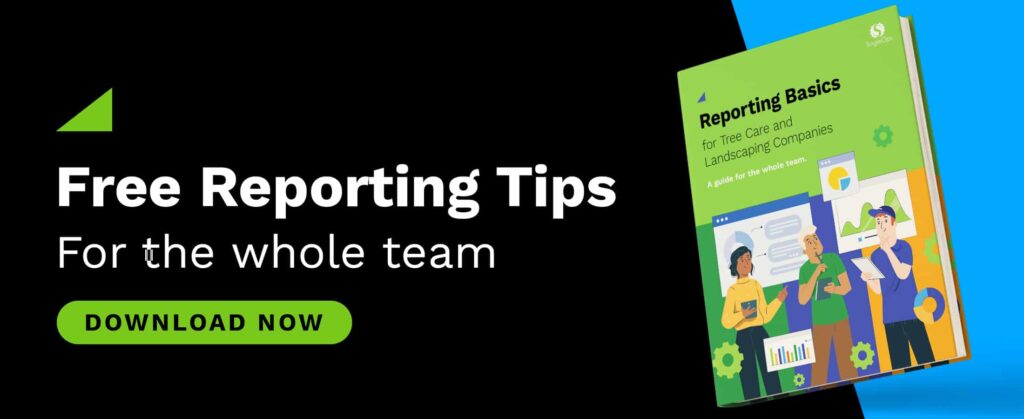Estimated vs. Actuals (Part 2 of 2 for Operations Managers)

This is the seventh and final blog in our series about Reporting for your Tree Care, Landscaping, or Lawn Care business. It’s also the second of two blogs explicitly written for Operations Managers in those businesses. Today, we’ll dive into monitoring your estimated v. actuals, also known as job costing.
What do We Mean by “Estimated vs. Actuals?”
As I mentioned, this is also referred to as “job costing” in some circumstances. A good definition comes from Finance Strategists:
Job costing is a system in which costs are assigned to batches or work orders of production…As a method of costing, job costing is applied to ascertain the costs of specific work orders, which are treated as small-sized contracts.
Phrased differently, tracking your “estimated vs. actuals” is monitoring how much material and time you think a job will require against the amount of time and material that job truly takes.
Why Track Estimated vs. Actuals?
There are several compelling reasons to track how closely your estimates for a job lined up with the actual time and material you used. Here are some excellent reasons to keep tabs on this for your business.
Keeps Profitability On Track
Without knowing whether your estimates are accurate, you’ll be entirely in the dark regarding whether or not you’re making money.
Green Industry consultants Jeffrey Scott and Adam Linneman talk at length about profitability for your business. Both would agree that knowing numbers, and making adjustments if they’re off, are critical for running a profitable business. We’ve also covered understanding and tracking your profitability in this post.
And it makes sense. At a fundamental level, if you estimate a job will take $200 worth of material and eight hours to complete, that’s how you bid the work. Let’s say, in this fictional example, that means you bid it at $500.
The customer accepts, but when your crew gets there, it becomes a full-day job for your two-person crew, and they need $350 in materials. That’s now $150 in just material you’re eating and the additional eight hours of pay and labor burden. Your profit is gone, and you lost money on that job.
Said differently, you paid for that job, not the end customer.
Tracking your estimated vs. actuals helps prevent this situation from becoming a regular occurrence. Otherwise, you’ll hemorrhage money and sink your business.
Keeps Cash Flow In Tact
It is related to the point above about profitability. If your profit margins are off, or you’re losing money rather than making it, cash flow quickly becomes a problem.
You’re out of business if you can’t repay loans, meet financial obligations to your vendors, or pay your staff.
Job Costing Prevents Small Problems from Becoming Big Problems
If you’re not tracking your proper hours on-site and material usage, you’re setting yourself up to fail.
Here’s a quick, real-life example of this. In Maryland, you’re restricted to 2.5 lbs. maximum in the amount of nitrogen you’re allowed to use for fertilizer for every 1,000 sq. ft. per year. Any more than 2.5 lbs. of N, and you’re facing significant fines or potentially losing your applicator’s license.

So – what if you haven’t been tracking your actuals? What happens if you’ve got a spreader with a defective setting or a new technician slightly over-applying on jobs for the year’s first half?
If you’re not tracking your actual material usage, you could face massive fines from the Department of Agriculture or lawsuits from environmental groups.
Shows Gaps in Training
What about that new tech who is possibly (accidentally) overapplying? If you’re tracking your estimated vs. actuals, you’ll see they need more training.
The same principle applies to your maintenance crews. What if you had enough mulch on-site, but you’ve got a crew that constantly seems to need just a bit more? Tracking your estimated v. actuals shows that they’re consistently over-applying the mulch too thick.
How about the Sales rep whose jobs seem to always come in under their profit target? Not a lot, but just enough to distance them from their more productive peers? Perhaps it’s an issue with the actual estimating, or they’re having a problem overcoming a particular objection. Maybe there’s a competitor in their geographic territory that’s way under-cutting them, and they are trying to remain competitive on price.
Tracking your estimated v. actuals will show you all these things. This allows you to dig into the “Why?” behind those numbers. Once you’ve identified the issue, you can invest in your team to make them feel valued AND protect your profits.
Tracking Estimated v. Actuals Helps You Forecast Material and Labor Needs
When you consistently apply job costing over several years, you gain enough historical data to make educated decisions about your material needs.
You’ll learn over time that for your average lawn, you mow “X” thousands of square feet. You will discover that your average mulching job requires so many yards of mulch. And you’ll find that your average pruning job requires so many man-hours of labor.
Using this information, work backward from your growth targets. If you want to grow your business by 20% next year, and you already run an efficient operation, you’ll need labor available to do 20% more work than you did this year. Knowing how many man-hours of labor you performed (your “actuals”), you’ll learn how many man-hours you need to add to your current capacity. That will tell you how many new hires you need to make.
The same principle holds for mulch, plant material, crushed stone, and fertilizer – all the materials you need to run your business effectively and efficiently. That is a great reason to track the difference between your estimates and actuals.
Avoid These Pitfalls When Tracking Estimates v. Actuals
Like anything else, when you’re pulling data, there’s a potential for things to go sideways. Numbers can be skewed, or you can get pushback from your team. Here are some common pitfalls to avoid and how to better serve your teams.
Avoid Using This Report to Discipline People
As I’ve already stated, this report is about helping run the business better and showing you where you can invest in people. This report is NOT about using the information you get to berate, belittle, or discipline your team.
Using the information from this report to “beat up” your team will only backfire on you. You’ll create an atmosphere of distrust. Your team will start putting in the information they think you want rather than the actual information. If what they hear from you is, “Why didn’t you get the Johnson job done on time?” they’ll just start fudging the numbers.
The best way to approach the gaps between your estimates vs. actuals is to engage in a conversation. A better approach is, “I see the Johnson job went over. I thought that one was bid pretty well. Did I make a bad assumption there? Or maybe you had a problem with the excavation that I hadn’t heard about? What happened, and most importantly, how can I help you overcome that challenge next time?”
This will increase trust and confidence in your system, and you’ll get the data and honesty you need from your team to make the best decision.
Lack of Transparency = Lack of Confidence
They might misinterpret your motives when your team doesn’t understand why you’re asking for the correct actuals. Don’t let that happen.
Communicate early and often with them about why you collect that data. Show them how good inputs equal good data outputs, resulting in sound business decisions. Teach them over time and by example that you’re not going to weaponize the information but that you’ll use it to understand their day-to-day challenges and make adjustments.
If the team doesn’t understand the importance of why you need accurate information, “getting it done” becomes the goal rather than “getting it done correctly.”
Tell them how you will use this information and stress their role in that process to get the best results.
Conclusion
Tracking your estimates vs. actuals is critical to managing your business correctly.
It helps you maintain profitability and cash flow, prevents minor problems from blowing up, helps you identify training needs, and helps you forecast material and labor needs.
Common pitfalls might be weaponizing the data and failing to communicate why you need it. Doing either gives you wrong data inputs, meaning the outputs will be useless.
Go back and read Part 6 – Understanding Your Backlog (1 of 2 for Ops Managers)
Download the FREE guide: Reporting Basics for Landscaping and Tree Care Companies